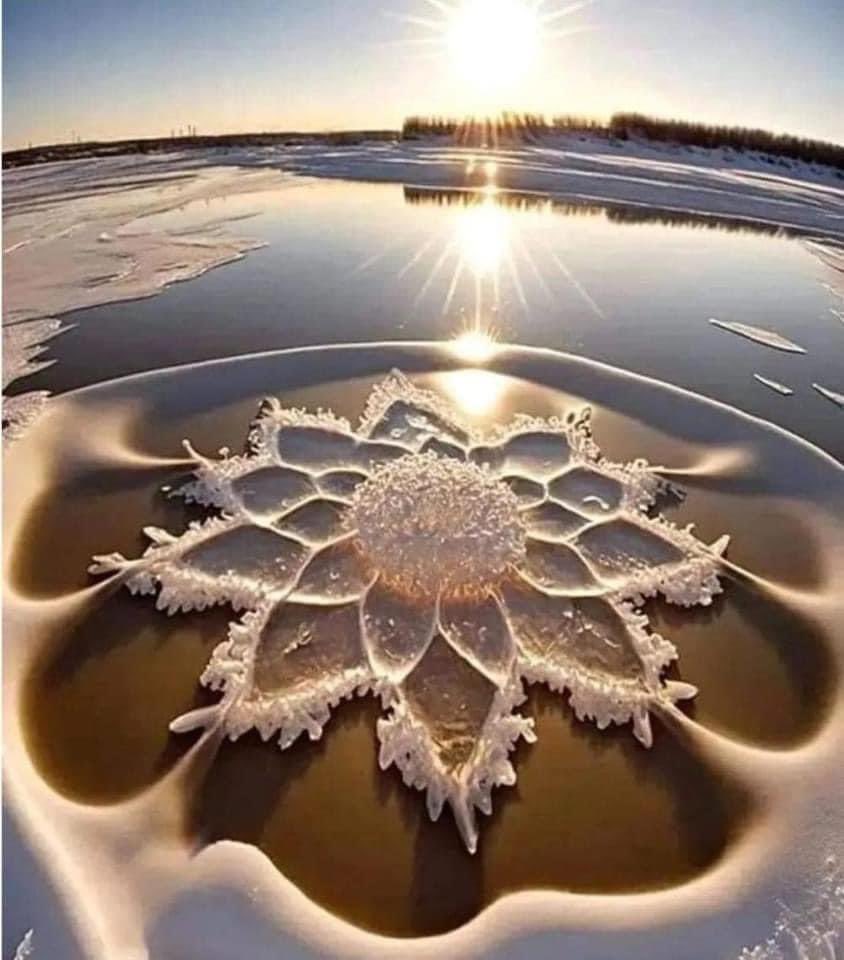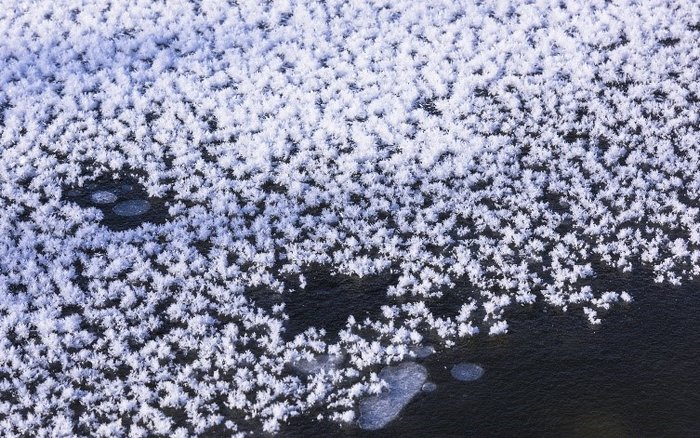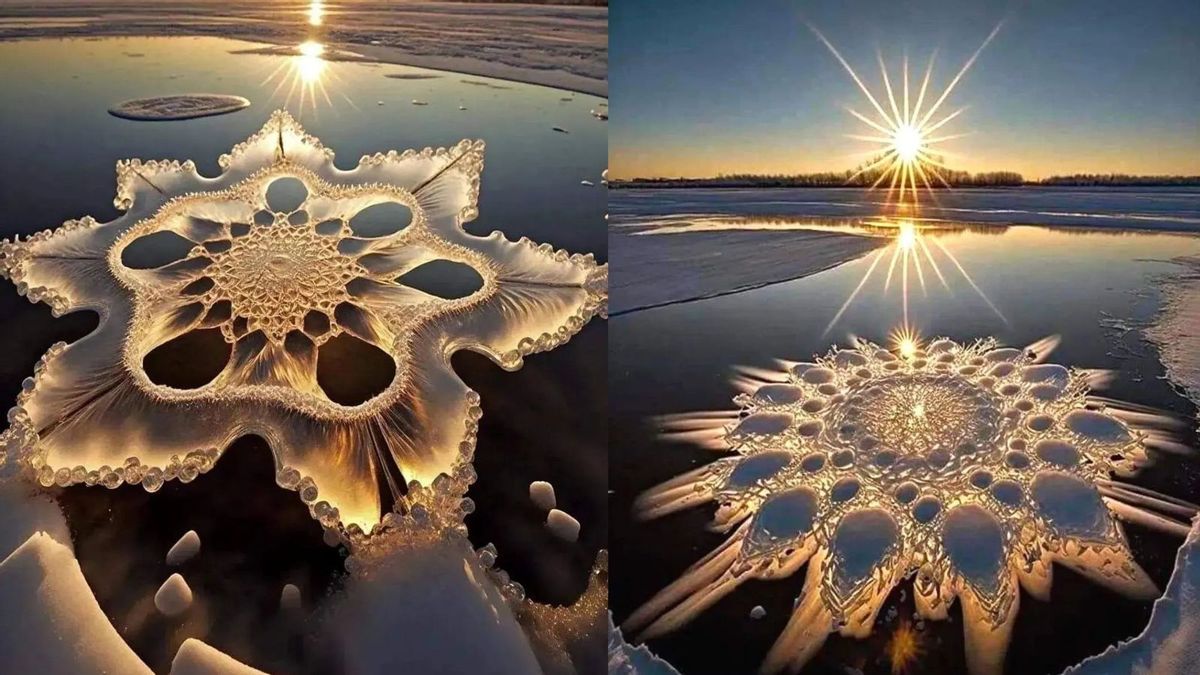Ice flowers in the Great Lakes form when supercooled water vapor crystallizes on the lake surface. This occurs during cold, calm conditions.
Ice flowers are a fascinating winter phenomenon found in the Great Lakes region. These delicate ice formations appear when the lake’s surface temperature drops below freezing, causing water vapor to crystallize into intricate patterns. The process requires specific weather conditions: calm winds and extremely cold air temperatures.
Ice flowers are most commonly seen on the lakes during early winter, before the lakes freeze over completely. Their fragile beauty draws nature enthusiasts and photographers alike, making them a popular subject for winter exploration. Understanding the formation of ice flowers enhances appreciation for the unique and transient beauty found in the Great Lakes during the winter months.
Ice Flowers

Ice flowers form on the Great Lakes through a unique process involving cold air, water vapor, and specific temperature conditions. As the air chills, water vapor crystallizes on the lake surface, creating delicate, flower-like ice structures. These formations often appear during early winter, adding a stunning visual element to the landscape.
The Phenomenon Of Ice Flowers
Ice flowers are stunning natural formations. They appear on the surface of the Great Lakes. These flowers form when temperatures drop rapidly. Moisture in the air freezes on thin layers of ice. This creates delicate, flower-like shapes. Ice flowers are often found in early winter. They add a magical touch to the landscape. They can be fragile and melt quickly. They are a rare and beautiful sight.
Significance Of Ice Flowers In The Great Lakes
Ice flowers are important for the ecosystem. They provide temporary habitats for small organisms. Birds and animals may find food near them. Ice flowers also indicate a healthy environment. They show that the air and water are clean. People enjoy seeing ice flowers. They attract photographers and nature lovers. Ice flowers make the Great Lakes even more special.
The Science Behind Ice Formation
Ice forms when water freezes. This happens at 0 degrees Celsius. Water molecules slow down and stick together. They form a solid. This solid is called ice. Crystals form in a pattern. This pattern is a hexagon. Ice flowers are special ice crystals. They need very cold air. The water temperature must be just above freezing. Tiny cracks in the ice let water seep out. It freezes quickly and forms a flower shape.
Calm and cold nights are best for ice flowers. The air must be very cold. The water must be slightly warmer. No wind is important. Wind can break the crystals. Humidity also plays a role. High humidity helps ice form. Tiny cracks in the ice are needed. Water seeps through these cracks. It freezes quickly and makes ice flowers.
Meteorological Factors At Play
Cold nights and warm days cause ice flowers to form. The temperature must drop below freezing at night. During the day, it needs to warm up just above freezing. This temperature fluctuation creates the perfect conditions for ice flowers. Water seeps out of plant stems and freezes quickly. The result is beautiful ice formations.
Wind patterns play a big role in ice flower growth. Light winds help water to seep out slowly. Strong winds can break the delicate ice formations. Calm days are best for ice flower formation. The wind also affects the shape of the ice flowers. Gentle breezes create unique patterns in the ice.
Water Properties Of The Great Lakes
The Great Lakes hold freshwater which is not salty. Freshwater freezes faster than seawater. This helps in ice formation.
Ice flowers need very cold temperatures. Freshwater allows these conditions. The lakes provide a perfect setting.
Wind is essential for ice flowers. The Great Lakes often have strong winds. These winds help in forming ice petals.
Calm and clear nights are another factor. They allow the water to freeze quickly. Ice flowers appear in the morning.
The lakes have large open areas. This space helps in the formation of ice flowers. More space means more ice petals.
Observing Ice Flowers

Ice flowers form during cold, calm mornings. The best time is at dawn. Lake Superior and Lake Michigan are the top spots. Look on the shores where the water is still. The flowers are delicate and melt quickly.
Bring a camera with a macro lens. Take pictures quickly because the flowers can melt. Use a tripod for steady shots. Document the date, time, and weather conditions. Share your findings with nature groups.
Ice Flowers And Ecosystem Interactions
Ice flowers in the Great Lakes form through a combination of cold air, water vapor, and calm conditions. These delicate structures arise when water vapor directly deposits onto surfaces, freezing instantly. This phenomenon creates intricate, frost-like formations that enhance the region’s natural beauty.
Influence On Local Wildlife
Ice flowers can affect local wildlife. Birds often find food around ice flowers. Small mammals seek shelter near them. These ice formations can create new habitats. This helps animals survive in cold weather. The ecosystem benefits from this interaction. It shows how nature adapts.
Interplay With Aquatic Plants
Ice flowers also interact with aquatic plants. These plants can get trapped in ice. This may slow down their growth. But it can also protect them from predators. The ice acts as a natural shield. This balance is crucial for the ecosystem. Ice flowers play an important role in maintaining it.
Human Interaction And Impact
Ice flowers attract many tourists each winter. People love taking photos of these unique formations. Local businesses benefit from the increased tourism. Restaurants and hotels see more visitors during this time. The natural beauty of ice flowers helps promote the Great Lakes. Families often come to enjoy the winter scenery. Ice flowers create a magical winter experience for all ages.
Conservation efforts are important to protect ice flowers. Volunteers help keep the areas clean. Litter can damage the delicate ice structures. Educational programs teach visitors about preserving nature. Signs remind tourists to respect the environment. Local groups work hard to protect these natural wonders. Together, we can ensure ice flowers remain for future generations.
Comparative Analysis
Ice flowers appear in many cold regions. In the Arctic, they form on sea ice. In Siberia, they form on frozen plants. The process is similar everywhere. Moisture from the air freezes on cold surfaces. Ice flowers can be found in Alaska and Antarctica too. Each region has its own unique ice flowers.
Great Lakes ice flowers are often larger. They form due to the lakes’ unique conditions. Other regions have different conditions. This affects their size and shape. Great Lakes ice flowers also have more intricate patterns. This makes them special and beautiful.

Conclusion
Ice flowers in the Great Lakes are a fascinating natural phenomenon. They form under specific cold conditions and with minimal wind. Observing these delicate structures can be a magical experience. Understanding their formation helps us appreciate the beauty and complexity of nature.
Discover more about nature’s wonders by exploring other related topics.






